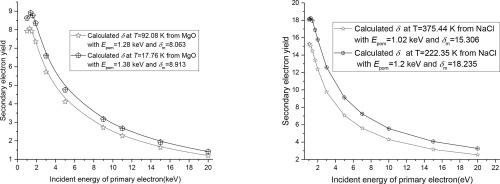Results in Physics ( IF 4.4 ) Pub Date : 2021-07-24 , DOI: 10.1016/j.rinp.2021.104554 Ai-Gen Xie 1 , Hong-Jie Dong 1 , Zheng Pan 1

|
The universal formulae for λ(χreal, Eg, T) and λ(χreal, Eg, T)p of insulator having less impurities are experimentally proved, where λ(χreal, Eg, T) is the mean escape depth at Kelvin temperature T of secondary electrons emitted from insulators with band gap Eg and efficient electron affinity χreal, λ(χreal, Eg, T)p is the λ(χreal, Eg, T) due to electron-lattice interaction. Based on the mechanism of electron-insulator interaction, experimental data, existing formulae, ESTAR program and formulae for λ(χreal, Eg, T) and λ(χreal, Eg, T)p of insulator having less impurities, the methods of obtaining λ(χreal, Eg, T)e-e, λ(χreal, Eg, T)e-defect and λ(χreal, Eg, T)i are presented, where λ(χreal, Eg, T)e-e is the λ(χreal, Eg, T) due to electron–electron interaction, λ(χreal, Eg, T)e-defect is the λ(χreal, Eg, T) due to electron–defect interaction, λ(χreal, Eg, T)i is the λ(χreal, Eg, T) due to electron-impurity interaction. The λ(χreal, Eg, T)p, λ(χreal, Eg, T)e-e, λ(χreal, Eg, T)e-defect and λ(χreal, Eg, T)i can provide corresponding information regarding electron-insulator interaction. Thus, it can be concluded that the method of investigating electron-insulator interaction by secondary electron emission SEE is successfully presented in this work. According to experimental data, formula for λ(χreal, Eg, T), ESTAR program, calculated parameters of primary range and existing formulae for SEE, the method of calculating the ẟ at different T and in the range of 1.0 keV ≤ Epo ≤ 100.0 keV from insulator having less impurities is successfully presented, where ẟ is secondary electron yield, Epo is incident energy of primary electron.
中文翻译:

任何开尔文温度下的电子-绝缘体相互作用和二次电子产率
实验证明了杂质较少的绝缘体的λ ( χ real , E g , T ) 和λ ( χ real , E g , T ) p的通用公式,其中λ ( χ real , E g , T )为平均逃逸从具有带隙E g和有效电子亲和势 χ real , λ 的绝缘体发射的二次电子在开尔文温度T下的深度( χ real , E g , T ) p是由于电子-晶格相互作用而产生的λ ( χ real , E g , T )。基于电子-绝缘体相互作用的机理、实验数据、现有公式、ESTAR 程序和λ ( χ real , E g , T ) 和λ ( χ real , E g , T ) p 的公式对于杂质较少的绝缘体,给出了λ ( χ real , E g , T ) ee、λ ( χ real , E g , T ) e-defect和λ ( χ real , E g , T ) i的获得方法,其中λ ( χ real , E g , T ) ee是λ ( χreal , E g , T ) 由于电子-电子相互作用, λ ( χ real , E g , T ) e-defect是λ ( χ real , E g , T ) 由于电子-缺陷相互作用, λ ( χ real , E g , T ) , E g , T ) i是λ ( χ real , E g , T) 由于电子-杂质相互作用。的λ(χ真实,ê克,Ť)p,λ(χ真实,ê克,Ť)EE,λ(χ真实,ê克,Ť)电子缺陷和λ(χ真实,ê克,Ť)我可以提供有关电子-绝缘体相互作用的相应信息。因此,可以得出结论,在这项工作中成功地提出了通过二次电子发射 SEE 研究电子-绝缘体相互作用的方法。根据实验数据,λ ( χ real , E g , T ) 的公式、ESTAR 程序、主要范围的计算参数和现有的 SEE 公式、不同T和 1.0 keV ≤ E范围内 的ẟ的计算方法po ≤ 100.0 keV 来自具有较少杂质的绝缘体被成功地呈现,其中ẟ是二次电子产率,E po是初级电子的入射能量。











































 京公网安备 11010802027423号
京公网安备 11010802027423号